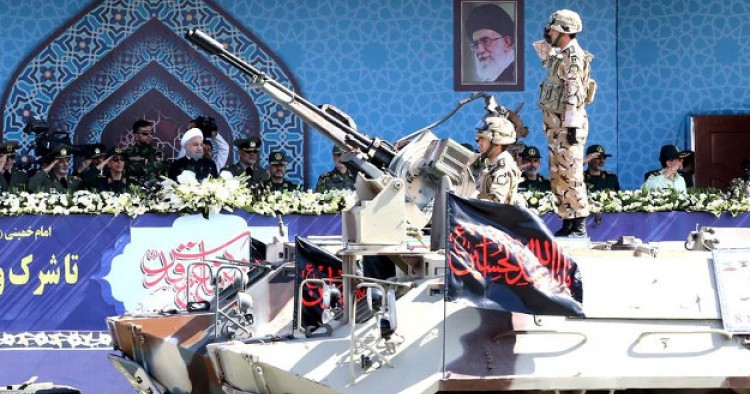Iran today unveiled a new ballistic missile with a range of 2,000 kilometer and capable of carrying multiple warheads, Iran’s Tasnim News Agency reported today. The missile is named Khorramshahr. The Khorramshahr missile was put on display during a military parade in Tehran. “This missile is a new achievement that the Ministry of Defense has produced for Sepah [Islamic Revolution Guards Corps], Brigadier General Amir Ali Hajizadeh, the commander of I.R.G.C. Aerospace Force said. “The Khoramshahr missile has a range of 2,000 kilometer and can carry a warhead up to 1,800 kilometer. It can carry more than one warhead,” he added. “The process of training in the ballistic Khoramshahr missile has begun and it will soon be put to operation by Sepah’s Aerospace Force.”
Comment: By displaying the new Khorramshahr ballistic missile, Tehran aimed to send a message of defiance to Washington. Speaking during Friday’s parade, Iranian President Hassan Rouhani said his country would continue to strengthen its missile program and other defense capabilities despite American demands. He emphasized that the Islamic Republic will seek no one’s permission to expand and enhance its defense programs. His remarks were directed President Donald Trump, who derided Tehran at the U.N. General Assembly for testing ballistic missiles and promoting violence and terrorism in the Middle East.
Iran’s refusal to halt its controversial ballistic missile program is likely to further heighten tension between Washington and Tehran. The Trump administration has taken a tougher approach toward Iran’s missile activity and has imposed new sanctions targeting Iranian entities associated with the program.
At the first press conference since winning reelection, Rouhani said that the Islamic Republic would continue its ballistic missile program despite Washington’s concerns. “American authorities should know that whenever we need to test a missile for technical reasons, we will carry it out. And we will not wait for them or their permission,” he said after U.S. and Saudi leaders criticized Tehran’s regional policies at the Riyadh summit.
Iran’s Supreme Leader Ali Khamenei has also stressed that his country will further enhance its missile power “We have missiles and they are very precise. They can hit targets with precision from thousands of kilometers away. We will forcefully preserve and enhance this capability."
While the nuclear agreement does not address Iran’s missile program, a subsequent U.N. Security Council Resolution 2231 “calls upon Iran not to undertake any activity related to ballistic missiles designed to be capable of delivering nuclear weapons, including launches using such ballistic missile technology.” Iranian leaders argue that the country’s missiles are not designed to carry nuclear warheads, but U.S. officials say some of the missiles Iran has tested after the 2015 nuclear deal have been "inherently capable of delivering nuclear weapons" and are "in defiance of" the U.N. resolution.
The Middle East Institute (MEI) is an independent, non-partisan, non-for-profit, educational organization. It does not engage in advocacy and its scholars’ opinions are their own. MEI welcomes financial donations, but retains sole editorial control over its work and its publications reflect only the authors’ views. For a listing of MEI donors, please click here.













